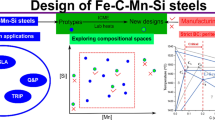Abstract
Continuous casting of peritectic steels is often difficult and critical; bad surface quality, cracks, and even breakouts may occur. The initial solidification of peritectic steels within the mold leads to formation of surface depressions and uneven shell growth. As commercial steels are always multicomponent alloys, the influence also of the alloying elements besides carbon on the peritectic phase transition needs to be taken into account. Information on the solidification sequence and phase diagrams for initial solidification are lacking especially for new steel grades, like high-alloyed TRIP-steels with high Mn, Si, and particularly high Al contents. Based on a comprehensive method development, the current study shows that differential scanning calorimeter measurements allow a clear prediction if an alloy is peritectic (i.e., critical to cast). In order to confirm these results, thermo-optical analyses with a high-temperature laser-scanning-confocal-microscope are performed to observe the phase transformations in situ up to the melting point.










Similar content being viewed by others
References
H. Murakami, M. Suzuki, T. Kitagawa, and S. Miyahara: Tetsu-to-Hagane, 1992, vol. 78, pp. 105-11.
Y. Sugitani, and M. Nakamura: Tetsu-to-Hagane, 1979, vol. 65, pp. 1702-11.
C. Bernhard: Berg und Huettenmännische Monatshefte, 2004, vol. 149, pp. 90-95.
R. Pierer, S. Griesser, J. Reiter and C. Bernhard: Berg und Huettenmännische Monatshefte, 2009, vol. 154, pp. 346-353.
A. Grill, and J.K. Briamcombe: Ironmaking and Steelmaking, 1976, vol. 2, pp. 76-79.
Y. Maehara, K. Yasumoto, H. Tomono, T. Nagamichi and Y. Ohmori: Materials Science and Technology, 1990, vol. 6, pp. 793-806.
R. Pierer and C. Bernhard: Materials Science and Technology, Cincinnati, 2006.
G. Xia, C. Bernhard, S. Ilie and C. Fürst: 6th European Conference on Continuous Casting, 2008, Riccione, Italy.
A. Jablonka, K. Harste and K. Schwerdtfeger: Steel Research, 1991, vol. 62, no.1, 24-33.
FactSage: Version 6.2, Database FSstel, Thermfact and GTT-Technologies, 2010.
M. Tisza: Physical Metallurgy for Engineers, ASM Metals Park Ohio, 2001.
ThermoCalc: Version 5, Database TCFE 6, Thermo-Calc Software, 2010.
J. Chipman: Metals Handbook, ASM Metals Park Ohio, 1973.
R. Sriniuasan: Engineering materials and metallurgy, Tarta, Mc Grawhill Education Private Ltd. India, 2010.
G. Xia: Habilitation Treatise, Chair of Metallurgy, University of Leoben, 2011.
T. Emi and H. Fredriksson: Materials Science and Engineering, 2005, vol. A413-414, pp. 2-9.
G. Xia, H. P. Narzt, C. Furst, K. Morwald, J. Moertl, P. Reisinger and L. Lindenberger: Ironmaking and Steelmaking, 2004, vol. 31, no.5, pp. 364-370.
M. Wolf: Continuous Casting Volume Nine, Zürich, Switzerland, 1997, pp. 59-68.
A.A. Howe: Applied Scientific Research, 1987, vol. 44, pp. 51-59.
A. Kagawa and T. Okamoto: Material Science and Technology, 1986, vol. 2, 998-1008.
K. E. Blazek, O. Lanzi Iii, P. L. Gano, and D. L. Kellogg: AISTech 2007, Indianapolis, 2007.
MTDat: Phase Diagram Software, The National Physical Laboratory, Version 5.1, 2012.
PANDAT: PanPhase Diagramm, CompuTherm LLC, 2012.
J. Lacaze and B. Sundman: Metall. Trans. A, 1991, vol. 22A, no.10, pp. 2211-2223.
J. Miettinen: Calphad, 1998, vol. 22, no.2, pp. 231-256.
D. Connetable, J. Lacaze, P. Maugis and B. Sundman: Calphad, 2008, vol. 32. no.2, pp. 361-370.
G.W. Höhne, H.W. Hemminger and H.J. Flammersheim: Differential scanning calorimetry: an introduction for practitioners, Springer, Berlin, 1996.
W.J. Boettinger, U.R. Kattner, K.-W. Moon, and J.H. Perepezko: DTA and Heat-flux DSC Measurements of Alloy Melting and Freezing, NIST Recommended Practice Guide, Special Publication 960-15, 2006.
Software: NETZSCH DSC/DTA Corrections, Version 2006.01, Netzsch-Gerätebau, 2006.
H. Yin, T. Emi and H. Shibata: ISIJ International, 1998, vol. 38, no.8, pp. 794-801.
N. J. McDonald and S. Sridhar: Journal of Materials Science, 2005, vol. 40, no.9-10, pp. 2411-2416.
M. Reid, D. Phelan and R. Dippenaar: ISIJ International, 2004, vol. 44, no.3, pp.565-572.
D. Phelan, M. Reid and R. Dippenaar: Metallurgical and Materials Transactions A, 2006, vol. A37, no. 3, pp. 985-994.
Acknowledgments
Financial supports by the Austrian Federal Government (in particular from the Bundesministerium für Verkehr, Innovation und Technologie and the Bundesministerium für Wirtschaft und Arbeit) and the Styrian Provincial Government, represented by Österreichische Forschungsförderungsgesellschaft mbH and by Steirische Wirtschaftsförderungsgesellschaft mbH, within the research activities of the K2 Competence Centre on “Integrated Research in Materials, Processing and Product Engineering,” operated by the Materials Center Leoben Forschung GmbH within the framework of the Austrian COMET Competence Centre Programme and the industry partners Siemens VAI Metals Technologies GmbH and voestalpine Stahl GmbH are gratefully acknowledged.
Author information
Authors and Affiliations
Corresponding author
Additional information
Manuscript submitted August 28, 2012.
Rights and permissions
About this article
Cite this article
Presoly, P., Pierer, R. & Bernhard, C. Identification of Defect Prone Peritectic Steel Grades by Analyzing High-Temperature Phase Transformations. Metall Mater Trans A 44, 5377–5388 (2013). https://doi.org/10.1007/s11661-013-1671-5
Published:
Issue Date:
DOI: https://doi.org/10.1007/s11661-013-1671-5




